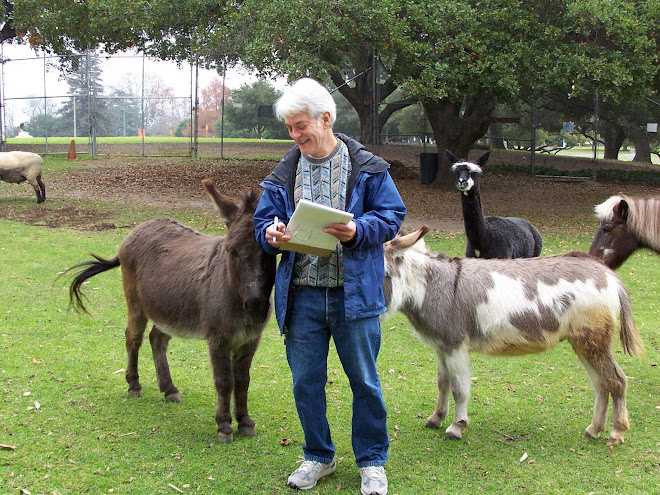





These pictures were taken by National Geographic photographer Norbert Rosing, who encountered a wild polar bear coming upon tethered sled dogs in the wilds of Canada 's Hudson Bay . He was sure that he was going to see the end of his dogs when the bear wandered in. The polar bear returned every night that week to play with the dogs.















4 comments:
http://www.thisislondon.co.uk/news/article-23433965-details/Baby+polar+bear+raised+by+humans+%27is+psycho%27/article.do
For more great polar bear pictures, artist Danica Phelps is hiring others to produce her work.
As part of her ``Material Recovery'' exhibition at the Zach Feuer Gallery, Phelps has opened a ``Stripe Factory.''
Workers sit in the gallery going about their business until an order comes in, then get to work laying the eight shades of brown stripes, line by line, in horizontal, vertical or square configurations. The minimum is 50,000 stripes, going for 15 cents each, with a three-way split among worker, Phelps and the gallery. Issues of fair pay, art produced on demand, price transparency and good working conditions all come into play.
For the past 10 years, Phelps has relentlessly chronicled her activities and expenditures in lists, grids and paint; prior canvases featured red stripes for money spent, green for earnings and gray for debt.
She made her last list in 2007. Here she takes individual letters from that final compiling and constructs them from trash: corrugated cardboard, plastic, paper and stuffed fabric. Hung mobile-like from the ceiling, the letters are a fragmented record of a much-examined life.
Also on view, pinned across three walls, are long scrolls depicting Phelps's recent trip to India for in vitro fertilization. Scenes of oxen, clinics, a sitar player, lorries, traffic and trees, rendered in the artist's spare, steady hand, are for sale by the inch.
Prices start at $40 per inch for the scrolled work and $7,500 for a stripe painting. Individual letters are $100.
``Danica Phelps: Material Recovery'' runs through July 18 at 530 W. 24th St.; +1-212-989-7700; http://www.zachfeuer.com.
R. Buckminster Fuller's geodesic domes dot the globe, from a weather station atop Mt. Fuji to the U.S. Pavilion at Expo 67 in Montreal.
Concurrent with a Fuller retrospective at the Whitney Museum of American Art, the Sebastian and Barquet Gallery and Carl Solway Gallery presents career-spanning examples of his work. They range from drawings for his 1928 book, ``4-D Time Lock'' -- with quick-assembly towers delivered by dirigibles -- to the ``Jitterbug,'' eight triangular pieces of aluminum and copper connected with flexible joints that allow the form to expand and rotate, unexpectedly shape-shifting with a touch.
A 1981 portfolio of Fuller's best designs, including the dome, his Dymaxion structures and three-wheeled car (Eleanor Roosevelt and H.G. Wells both went for a spin in it) are well displayed by layering schematics of the design over photographs of the finished product. They capture both the engineering and futuristic aspect of his visionary explorations. Prices range from $3,000 to $60,000.
``Buckminster Fuller: Everything I Know'' runs through Aug. 23rd at 544 W. 24th St.; +1-212-691-3215; http://www.sebastianbarquet.com.
An errant iceberg run aground in Lubeck, Germany, in 1923 looms over the town's church steeples, feeding fears of melting ice caps among a populace already coping with spiraling inflation.
The art team of Kahn/Selesnick deals with all-too-familiar economic and ecological concerns as they reimagine history through photographs, paint and installation at the Yancey Richardson Gallery.
Kicking off their fantastical visual narrative, 25 black- and-white images, including the iceberg shot, are grouped within a single white frame: a bourgeois trio fuels their fireplace with paper money; sewn-together bills serve as clothing, and, sending the whole matter up, a man defecates useless currency as he squats in an ice cave.
That cold redoubt is part of the imagined Eisbergfreistadt, or Iceberg Free State, brought to life in 8-foot-wide color panoramas: Men dig a body out of the ice while zeppelins and seaplanes ply the skies overhead, or a figure in polar bear disguise maneuvers a long kayak atop an ice floe.
That 16-foot craft, made of anaconda skin, sits mid-gallery among other disquieting ephemera: a push cart piled high with useless money, a mannequin in a currency coat and an antique soup tureen full of marzipan polar bears.
Prices range from $1,200 to $15,000.
http://www.squidoo.com/polarbearaware
Blogbetter.
Great blog:
http://doubleday.blogspot.com/2006/05/legacy-of-polar-bear.html
Post a Comment